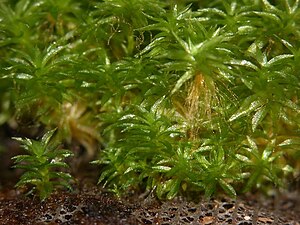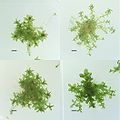Small bubble cap moss
| Small bubble cap moss | ||||||||||||
|---|---|---|---|---|---|---|---|---|---|---|---|---|

Little bladder cap moss ( Physcomitrella patens ) |
||||||||||||
| Systematics | ||||||||||||
|
||||||||||||
| Scientific name | ||||||||||||
| Physcomitrella patens | ||||||||||||
| ( Hedw. ) Bruch & Schimp. |
The little bladder cap moss ( Physcomitrella patens ) is a deciduous moss from the Funariaceae family . It serves as a model organism in research into the evolution , development and physiology of plants .
features
Kleistocarp sporophyte (spore capsule) of Physcomitrella patens
Axenic in vitro - cultivation of Physcomitrella patens
Moss bioreactor with Physcomitrella patens
From Physcomitrella - wild type derived (A) phenotypes (BD).
The plants reach heights of up to 5 mm and stand in loose herds. The upper leaves are enlarged, broadly lanceolate and bluntly serrated on the edge. The leaf vein ends just below the leaf tip. The lamina cells are large and rhombic.
Physcomitrella patens is a cleistocarpic moss. The capsule has no lid and is spherical with a short tip. It stands on a short seta and is surrounded by leaves.
The species is very short-lived, it completes its life cycle in just four weeks.
Distribution and locations
The species occurs in Eurasia and North America. It grows on muddy or clayey soils, especially on dry river banks and drained ponds. It is missing in higher altitudes.
development
The haploid meiospore germinates under the influence of light and water to form the filamentous protonema (sometimes also called “pre-germ” or, especially in the old literature, “conference threads”), which initially consists of chloronema cells. Under the influence of auxin, it differentiates into caulonema cells. Both cell types grow through single-edged apex cells . The protonema represents the juvenile form of the gametophyte . The transition to growth under the influence of cytokinin by means of three-edged parietal cells, the induction of the moss bud, marks the transition to the adult gametophyte, the moss plant divided into stems, leaflets and rhizoids (see also thallus ) . Since this terminal carries the gametangia , the female archegonia and the male antheridia ( Physcomitrella patens is monoecious ), these moss plants are also called gametophores in the technical term . The induction of gametangia occurs in Physcomitrella in the short day and at low temperatures. Each archegonium contains an egg cell. The fertilization of the egg by the freely moving spermatozoids requires the archegonium and antheridium to be connected by water, for example by a dew drop. The embryo developing in the archegonium represents the diploid sporophyte (the "moss capsule"). It lives epiphytically on the gametophore and is nourished by it. Physcomitrella carries a maximum of one spore capsule per gametophore, that is, of the several fertile archegonia per gametophore only one develops into a mature sporophyte. The sporophyte that develops in the archegonium tears the archegonium apart as it grows. The archegonia neck remains loosely attached to the sporophyte - this remainder is known as the kalyptra . At the bottom, the sporophyte is connected to the gametophor via a “stalk”, the seta . In Physcomitrella patens the seta is very short and the sporophyte is secondarily reduced; he is celistocarp . This means that the meiospores formed in the sporophyte after the meiosis do not leave the sporophyte through a predetermined opening, but that the sporophyte must tear or burst in order to release the spores.
Model organism
Physcomitrella patens is used as a model organism because it is the only known plant with very efficient homologous recombination . In this capacity, like P. patens of baker's yeast . Using this technique of gene targeting , a DNA fragment can be integrated at a predetermined location in the genome . The knockout mosses produced in this way are helpful in elucidating the function of genes . This technique is called reverse genetics . In this way, questions about the evolution of plants can be solved. The genome of P. patens with around 500 million base pairs (Mbp) organized in 27 chromosomes was completely sequenced in 2007. The number of genes was determined to be 34,835.
In addition, P. patens is important in biotechnology , for example in the production of pharmaceuticals in a moss bioreactor developed by Ralf Reski .
Various ecotypes , mutants and transgenic strains of P. patens are deposited at the International Moss Stock Center .
Individual evidence
- ↑ Tanja Egener, José Granado, Marie-Christine Guitton, Annette Hohe, Hauke Holtorf, Jan M. Lucht, Stefan A. Rensing, Katja Schlink, Julia Schulte, Gabriele Schween, Susanne Zimmermann, Elke Duwenig, Bodo Rak & Ralf Reski: High frequency of phenotypic deviations in Physcomitrella patens plants transformed with a gene-disruption library . In: BMC Plant Biology . 2, 2002, p. 6. doi : 10.1186 / 1471-2229-2-6 . PMID 12123528 . PMC 117800 (free full text).
- ↑ a b c Jan-Peter Frahm, Wolfgang Frey, J. Döring: Moosflora . 4th, revised and expanded edition (UTB for Science, Volume 1250). Ulmer, Stuttgart 2004, ISBN 3-8001-2772-5
- ↑ Jan-Peter Frahm: Biology of the mosses . Spectrum Akademischer Verlag, Heidelberg and Berlin 2001, p. 122. ISBN 3-8274-0164-X
- ↑ a b c d e Ralf Reski (1998): Development, genetics and molecular biology of mosses. Botanica Acta 111, 1-15.
- ^ A b Eva L. Decker, Wolfgang Frank, Eric Sarnighausen, Ralf Reski (2006): Moss systems biology en route: Phytohormones in Physcomitrella development. Plant Biology 8, 397-406.
- ↑ a b Annette Hohe, Stefan A. Rensing, Manuel Mildner, Daniel Lang, Ralf Reski (2002): Day length and temperature strongly influence sexual reproduction and expression of a novel MADS-box gene in the moss Physcomitrella patens . Plant Biology 4, 595-602.
- ^ Ralf Reski (1998): Physcomitrella and Arabidopsis : the David and Goliath of reverse genetics. In: Trends in Plant Science. Vol. 3, pp. 209-210. doi : 10.1016 / S1360-1385 (98) 01257-6
- ↑ Ralf Reski and Wolfgang Frank (2005): Moss (Physcomitrella patens) functional genomics - Gene discovery and tool development with implications for crop plants and human health. In: Briefings in Functional Genomics and Proteomics. Vol. 4, pp. 48-57. PDF ( page no longer available , search in web archives ) Info: The link was automatically marked as defective. Please check the link according to the instructions and then remove this notice.
- ↑ a b c Rensing, SA et al. (2008): The Physcomitrella genome reveals evolutionary insights into the conquest of land by plants. In: Science. Vol. 319, No. 5859, pp. 64-69, doi: 10.1126 / science.1150646 .
- ↑ Ralf Reski, Merle Faust, Xiao-Hui Wang, Michael Wehe, Wolfgang O. Abel (1994): Genome analysis of the moss Physcomitrella patens (Hedw.) BSG. Molecular and General Genetics 244, 352-359, doi: 10.1007 / BF00286686 .
- ↑ Complete proteome at UniProt .
- ↑ KB: greenovation - a small moss works successfully as a protein biofactory. Archived copy ( memento of the original from October 13, 2011 in the Internet Archive ) Info: The archive link was inserted automatically and has not yet been checked. Please check the original and archive link according to the instructions and then remove this notice.
Web links
- Small bladder moss expresses human proteins
- Little bubble cap moss lets knowledge about RNA interference grow in plants
- Small bubble cap moss really big
- Optimized biopharmaceuticals from moss cells
- FRISYS: Plants show nerves
- First deciphered moss genome: From land conqueror to drug producer
- Small moss with a great future
- Website International Moss Stock Center (IMSC) Freiburg





